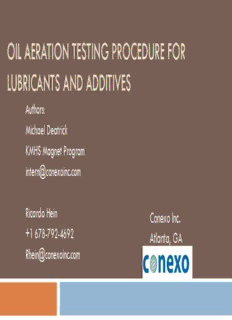
Oil Aeration Testing Procedure for Lubricants and Additives PDF
Preview Oil Aeration Testing Procedure for Lubricants and Additives
OIL AERATION TESTING PROCEDURE FOR LUBRICANTS AND ADDITIVES Authors: Michael Deatrick KMHS Magnet Program [email protected] Ricardo Hein Conexo Inc. +1 678-792-4692 Atlanta, GA [email protected] Oil Aeration Research Study Project to investigate oil aeration with use of different antifoams and used oils with fuel dilutions Evaluated with agitated samples creating a vortex that produces a windage in the sample, strong enough to be sustained. Test of different types of antifoam blended into reference base oil Test also samples of used oil with different % of fuel dilution, not considering the contents of soot, water, and overall composition For accomplishing the project, developed a new method for testing aeration with high reliability and repeatability Oilpas Measurement Using Oilpas instrument to measure aeration in real-time opened possibility to measure aeration and deaeration speeds, and variations over time Measurement achieved by sampling a small volume of oil and circulating it through a test cell in an imaging instrument. The dispersed air separates in bubbles and it is recorded by an optical method Using air bubble count and size distribution, a value for the dispersed gas concentration is calculated in real-time, and it shows good correlation to the dynamic machine operation Setup 10 Aeration of Different Degrees of Synthetic Oil 1 e g a t n e c r e P 0.1 n o i t a r e A Semisynthetic Oil 0.01 Synthetic Oil Mineral Oil 0.001 0 100 200 300 400 500 600 700 800 900 1000 1100 1200 1300 1400 1500 1600 1700 1800 1900 2000 2100 2200 2300 2400 2500 2600 2700 2800 Time (In seconds) Evaluation OIL Aeration % when Aeration % after 5 Highest Aeration % Stable min. of Deaeration Level Reached Synthetic Oil 0.05 0.01> 0.2 Semi-Synthetic Oil 5 1 6.0 (5W-20) Mineral Oil 5 0.5 6.0 Different base oils show noticeable differences in the aeration levels and in the deaeration speed. 12 Aeration of Different Antifoam Compositions in Oil Reference Oil POA #2 OMS #2 10 POA #1 OMS #1 Si #2 Si #1 8 e g a t n e c r e P 6 n o i t a r e A 4 2 0 0 100 200 300 400 500 600 700 800 900 1000 1100 1200 1300 1400 1500 1600 1700 1800 1900 2000 2100 2200 2300 2400 2500 2600 2700 2800 2900 3000 Time (In seconds) Evaluation OIL Aeration % when Aeration % after 5 Highest Aeration % Stable min. of Deaeration Level Reached Reference Oil 3.5 0.6 5.0 Si Antifoam #1 6.2 2.7 11.2 Si Antifoam #2 3.0 1.0 4.1 OMS Antifoam #1 2.0 0.7 2.7 OMS Antifoam #2 2.0 0.3 3.0 POA Antifoam #1 1.5 0.2 1.5 POA Antifoam #2 1.9 0.2 2.3 Traditional antifoam agents may cause a negative effect in oil aeration Some chemical families have a positive effect at lowering oil aeration Differentiation between defoamers and deaerators, two different effects and processes in oil 6 Aeration of Different Combinations of Antifoams 5 4 OMS and Si e g a OMS and POA t n e Si and POA c r e P 3 Reference Oil n o i t a r e A 2 1 0 0 100 200 300 400 500 600 700 800 900 1000 1100 1200 1300 1400 1500 1600 1700 1800 1900 2000 2100 2200 2300 2400 2500 2600 2700 2800 2900 3000 3100 3200 Time (In seconds)
Description: